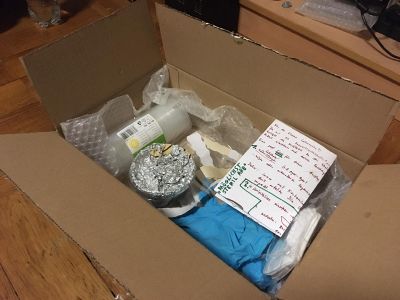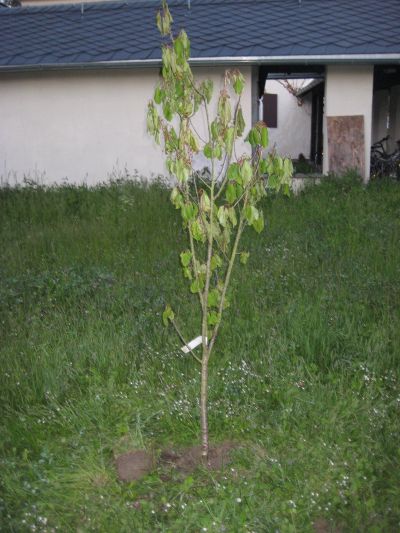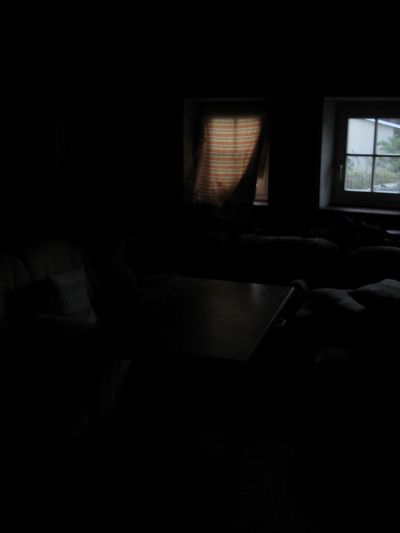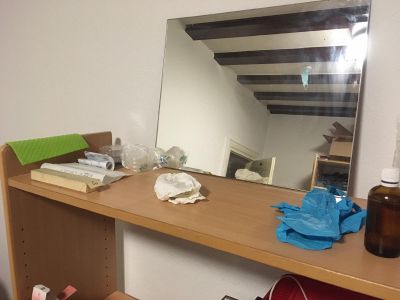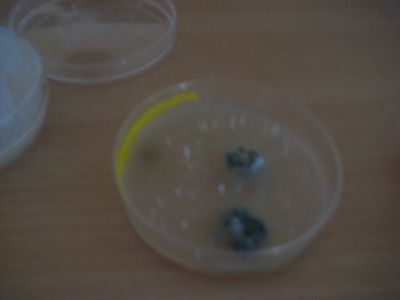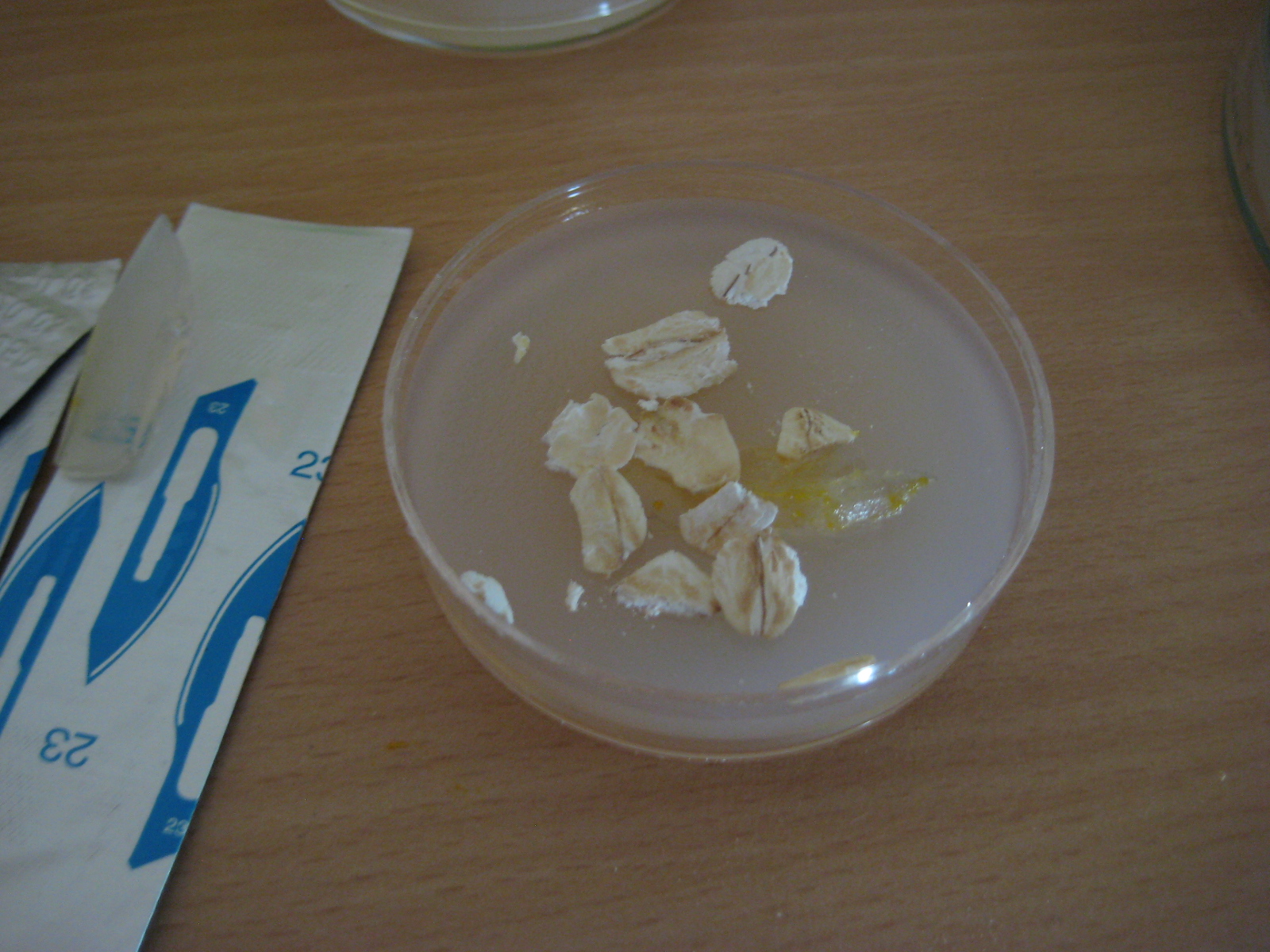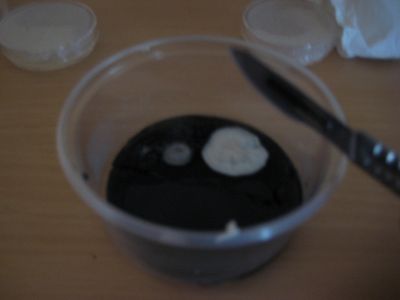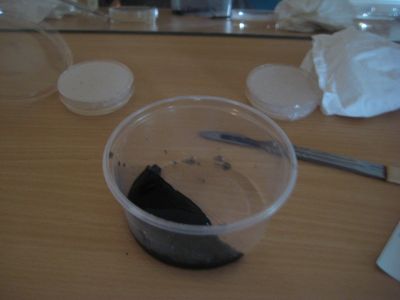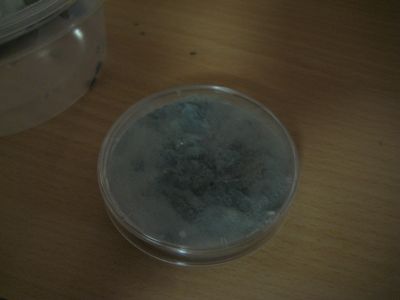No edit summary |
No edit summary |
||
| Line 72: | Line 72: | ||
"Well, that didn't work"''' | "Well, that didn't work"''' | ||
[[File:IMG_0162.JPG|400px]] | |||
As was to be expected, the Physarum lost it's fight against the mold. I take comfort in the thought that this was a practice run, since what I worked with was damaged from the start. Determined to start again I make arrangements for another batch. | |||
Revision as of 01:16, 12 June 2021
Homunculus Cinema
Synopsis
The Work consists of two parts: The physical environment, the „cinema“, the darkened box in which the slime molds will be permanently placed, if possible grown into a humanoid shape by means of a „skeleton“ consisting of wire and oat flakes and eventually subjected to screenings of Paul Sharits' „Word Movie“. The second part consists of an extensive study, part examination of the experiments, part essayistic interpretation of the project and diary of the researcher. The scientific nature of it will be fictional, a „documentary fiction“, which means the writings will ultimately be literary, though staying true to the form of a scientific study. Additionally, a shortened version of this concept will hint at the implications of the work (alchemy, pseudo- and protoscience, questions of perception and the self, irrationality) which are not directly spelled out in the study.
Put even simpler: 1: a group of slime molds will be cultivated onto a human-shaped „skeleton“, 2: those figurines will be examined, each watching a different part of „Word Movie“ in a darkened room on repeat, the relationship of the observer to the figures will be described in the context of the „homunculus“-concept, 3. Their reaction to the film sequences will be examined in a fictional study, which will also discuss the cultural and philosophical implications of the homunculus, literally and metaphorically, the perceptiveness of slime molds, and the attempt to communicate to them via film.
Idea
Growing the slimemold onto a human shaped form wich is watching a different part of "Word Movie". The reaction of these objects get observed, described an put in the concept of the "homunculus". This gets documentet and examined in a fictional study.
Technical steps
A human shaped "skeleton" has to be made and a concept of how the "skeleton" should watch the movie. This can be a projection or a screen.
DIARY - From the Desk of Professor Pyg
(part of this diary will be written from the perpective of the fictional researcher, named after the charactor from the song "Pygmalism", a song by Momus, which deals with the myth of Pygmalion, another parallel to the "homunculus" trope. those aspects will be in {...} brackets.)
21.5. A friend in need is a friend indeed
Assorted leftover lab equipment provided by a friend arrives straight from the Biolab of HU Berlin, with a detailed description on how to use it. I have no Slime Mold to call my own yet and get to organising the adoption of one. Meanwhile work on the concept, which is expanding quickly. The different Ideas are too interconnected to prioritise, at least at this point.
24.5.
Though I still don't have my Slime Mold yet, it is already very present in my mind, the mere anticipation of being responsible for a sensitive life form, one that am hardly familiar with, has already occupied my idle thoughts. Recently I noticed that I never really had room plants to call my own, something that I was already planning to change in Weimar. While walking, I found an uprooted cherry tree, left outside of a house for bypassers to pick up. Since my thoughts are already with the idea of cohabitation and tending to other organisms, I simply can't deny this chance. Looks like I'll have to develop my green thumb at the same time as my yellow one.
26.5. I have received my Slime Mold, but realise I have underestimated the sudden responsibility. When receiving the Petri-Dish, physically, I suddenly feel a certain metaphysical weight. The unopened sample does radiate a certain mystery too, the physarum is definitely a "felt presence" in my room.
The next days are marked by a kind of irritated nervousness about the sudden responsibility. Each day I realise, there is something else in my toolbox that's missing (specific 70/30 desinfectant, purified water, a kitchen scale to get the right water-agar-ratio), so each day I make another walk into town, only to realise I am still not ready. I grow worried about the physarum. Paralleled with this are the same struggles with my cherry tree, the same discrepancy between imagination and practice - I realise I don't have the right tools to open the earth and my tree remains unplanted for a couple of days, before I manage to borrow a heavy shovel from a neighbour.
A lesson in austerity is also the struggle to find an adequate space for my laboratory. The dormitory I live in is dirty and poorly equipped with furniture. The "club room", with it's projector screen, which served as the first inspiration for the "homunculus cinema" is dark and largely unused, but there is no good surface to work on.
29.5. I make room on the top shelf of my laboratory and manically disinfect the surfaces, as well as everything I touch the surfaces with. At least the laboratory is at an unusually comfortable height for precision work.
1.6.
While trying to prepare the media and the petri-dishes in a decidedly un-sterile environment, I suddenly understand how people become germ-fearing, compulsively washing neat freaks. From cooking the agar in an old kitchen pot, to repeatedly disinfecting everything that somehow physically comes into contact with anything else over and over, always feeling I have broken the chain of sterility somewhere along the line.
False Starts Paula, who donated her Physarum Sample, informs me she gave me the wrong petri-dish by accident. When I open the foil around the dish, I see what she means. The dish consists almost entirely of mold, only at the very edge there are traces of Physarum.
My friend from Berlin, who also provided some special media to experiment with, added two dishes of BM5, which as he tells me, is especially nutritious and used for plant embryos. However, he also had a mishap, one of the two dishes already had a big mold in it, when it arrived. I realise I will most likely have to get another batch of Physarum, but decide to make the most of it. I attempt to isolate the traces from the edge of the dish as good as I can and implant them into newly prepared agar dishes.
Since the damage is done, I cut away the mold from the BM5, and implant some Physarum on it too, just to see if how it behaves. Luckily I still have another, uncontaminated BM5 medium that I save for when I eventually obtain an uncontaminated Physarum.
5.6. "Well, that didn't work"
As was to be expected, the Physarum lost it's fight against the mold. I take comfort in the thought that this was a practice run, since what I worked with was damaged from the start. Determined to start again I make arrangements for another batch.
